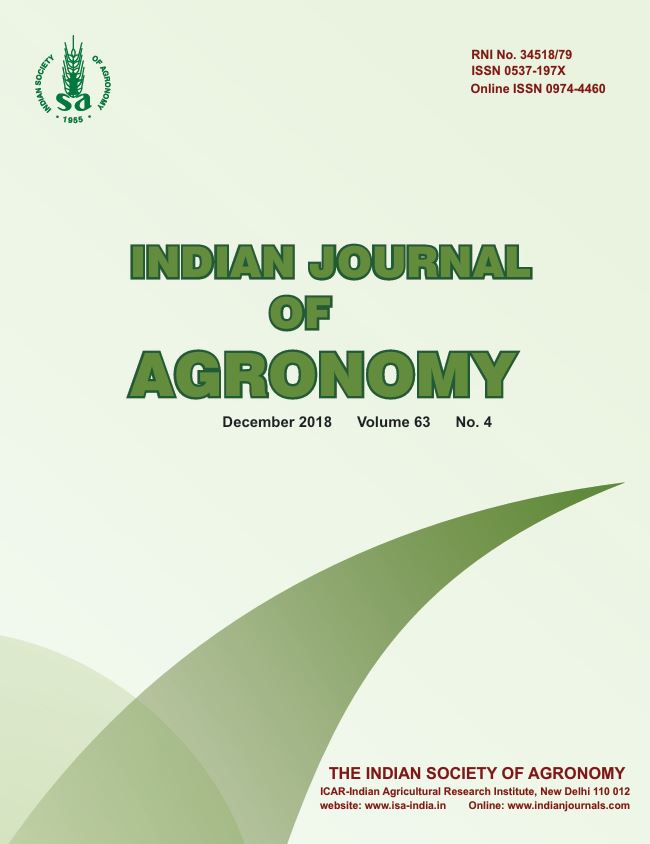Varieties and phosphorus fertilization effects on productivity and profitability of direct-seeded upland rice (Oryza sativa) in Eastern India
DOI:
https://doi.org/10.59797/ija.v63i4.5691Keywords:
Cultivars, Direct-seeded upland rice, Microbial inoculants, Phosphorus fertilizationAbstract
A field experiment was conducted during rainy (kharif) season of 2016 at Hazaribag, Jharkhand to study the effect of varieties and phosphorus (P) applications on grain yield and economics of direct-seeded upland rice (Oryza sativa L.). The experiment was laid out in split plot design with three replications, keeping 3 rice varieties, viz. ‘Vandana’, ‘Anjali’ and ‘CR Dhan 40’, in the main plots and 7 different P rates. viz., 0 kg/ha, phosphorus solubilizing bacteria (PSB) + arbuscular mycorrhizal fungi (AMF), 13.2 kg P/ha through single super phosphate (SSP), 13.2 kg P/ha through SSP + PSB + AMF, 26.4 kg P/ha through SSP, 26.4 kg P/ha through SSP + PSB + AMF and 39.6 kg P/ha through SSP in the sub-plots. The results revealed that yield attributes, viz. effective tillers/m2 (312), filled grains/panicle (130), panicle weight (27.9 g), 1,000-grain weight (22.5 g), and grain (3.91 t/ha) and straw yields (6.17 t/ha) were higher in ‘CR Dhan 40’ compared to ‘Anjali’ (259, 115, 2.04 g, 20.4 g, 3.33 t/ha and 5.64 t/ ha respectively) and ‘Vandana’ (252, 108, 1.78 g, 19.9 g, 3.12 t/ha and 5.53 t/ha respectively). Similarly, application of 39.6 kg P/ha through SSP recorded the highest values for yield attributes, grain (4.25 t/ha) and straw yields (6.79 t/ha), and was at par with 26.4 kg P/ha through SSP + PSB + AMF. Net returns and B:C ratio were also recorded the highest in ‘CR Dhan 40’ with 39.6 kg P/ha through SSP, which was at par with 26.4 kg P/ha through SSP + PSB + AMF. Thus, integrated application of 26.4 kg P/ha through SSP along with PSB and AMF in ‘CR Dhan 40’ can enhance grain yield and net returns of direct-seeded upland rice in Jharkhand.
References
Fageria, N.K., Morais, O.P., Baligar, V.C. and Wright, R.J. 1988. Response of rice cultivars to phosphorus supply on an oxisol. Fertilizer Research 16(3): 195–206.
Gaind, S. and Singh, Y.V. 2016. Short-term impact of organic fertilization and seasonal variations on enzymes and microbial indices under rice–wheat rotation. Journal of Crop Improvement 29(1): 23–29.
Maiti, D., Singh, C.V., Variar, M., Mandal, N.P. and Anantha, M.S. 2013. Impact of rainfall pattern on native arbuscular-mycorrhizal activity influencing phosphorus utilization by direct seeded rainfed upland rice (Oryza sativa L.). Proceedings of the National Academy of Sciences, India Section B: Biological Sciences 83(2): 159–162.
Richardson, A.E., Lynch, J.P., Ryan, P.R., Delhaize, E., Smith, F.A., Smith, S.E., Harvey, P.R., Ryan, M.H., Veneklaas, E.J., Lambers, H. and Oberson, A. 2011. Plant and microbial strategies to improve the phosphorus efficiency of agriculture. Plant and Soil 349(1-2): 121–156.
Richardson, A.E. and Simpson, R.J. 2011. Soil microorganisms mediating phosphorus availability update on microbial phosphorus. Plant Physiology 156(3): 989–996.
Sepat, S., Ahlawat, I.P.S. and Rana, D.S. 2012. Effect of phosphorus sources and levels on Bt-cotton (Gossypium hirsutum) based intercropping systems. Indian Journal of Agronomy 57(3): 235–240.






